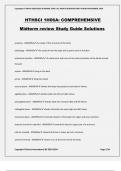Copyright © KAYLIN 2024/2025 ACADEMIC YEAR. ALL RIGHTS RESERVED FIRST PUBLISH NOVEMBER, 2024
HTHSCI 1H06A: COMPREHENSIVE
Midterm review Study Guide Solutions
anatomy - ANSWER✔✔-the study of the structure of the body
physiology - ANSWER✔✔-the study of how the body and its parts work or function
anatomical position - ANSWER✔✔-To stand erect with arms at the sides and palms of the hands turned
forward
supine - ANSWER✔✔-lying on the back
prone - ANSWER✔✔-lying face down
coronal plane - ANSWER✔✔-divides the body into posterior and anterior halves
sagittal plane - ANSWER✔✔-divides body into left and right halves
parasagittal plane - ANSWER✔✔-Divides body into unequal right and left halves
midsagittal plane - ANSWER✔✔-divides the body into equal right and left halves
transverse plane - ANSWER✔✔-horizontal division of the body into upper and lower portions
superior (cranial or cephalic) - ANSWER✔✔-toward the head or upper part of a structure
inferior (caudal) - ANSWER✔✔-towards the foot or lower part of a structure
anterior (ventral) - ANSWER✔✔-nearer to or at the front end of the body
Copyright ©Stuvia International BV 2010-2024 Page 1/34
,Copyright © KAYLIN 2024/2025 ACADEMIC YEAR. ALL RIGHTS RESERVED FIRST PUBLISH NOVEMBER, 2024
posterior (dorsal) - ANSWER✔✔-nearer to or at the back of the body
deep - ANSWER✔✔-toward the interior or inside of the body
superficial - ANSWER✔✔-towards the surface or outside of the body
medial - ANSWER✔✔-nearer to or at the midline of the body
lateral - ANSWER✔✔-nearer to or at the side of the body
proximal - ANSWER✔✔-nearer to the point of attachment of a limb or origin of a structure
distal - ANSWER✔✔-nearer to the far end or point of a limb/structure
extension - ANSWER✔✔-movement that increases the angle between body parts
flexion - ANSWER✔✔-movement that decreases the angle between body parts
Abdominal Regions - ANSWER✔✔-Right hypochondriac, Epigastric, Left hypochondriac
right lumbar, umbilical, left lumbar
right iliac, hypogastric, left iliac
Thoracic landmarks - ANSWER✔✔-ribs and intercostal spaces
cranial cavity - ANSWER✔✔-cavity that contains the brain and spinal cord
pericardial cavity - ANSWER✔✔-body cavity that contains the heart
peritoneal cavity - ANSWER✔✔-cavity containing the abdominopelvic organs (GI and reproductive)
pleural cavity - ANSWER✔✔-contains the lungs
parietal layer - ANSWER✔✔-layer lining the internal surface of the body wall
Copyright ©Stuvia International BV 2010-2024 Page 2/34
,Copyright © KAYLIN 2024/2025 ACADEMIC YEAR. ALL RIGHTS RESERVED FIRST PUBLISH NOVEMBER, 2024
visceral layer - ANSWER✔✔-layer covering the external surface of organs
serous membrane - ANSWER✔✔-a thin membrane composed of a single layer of epithelial cells that
lines the parietal and visceral layers, secreting a small amount of slippery serous fluid
potential space - ANSWER✔✔-area between the visceral and parietal layers that has the potential to be
filled with fluid, blood, or air
Bones of the axial skeleton - ANSWER✔✔-skull, sternum, ribs, vertebrae (including sacrum and coccyx)
Bones of the upper limb of the appendicular skeleton - ANSWER✔✔-scapula, clavicle, humerus, radius,
ulna, carpal bones, metacarpals, phalanges
Bones of the lower limb of the appendicular skeleton - ANSWER✔✔-pelvic (os coxae), femur, patella,
tibia, fibula, tarsal bones, metatarsals, phalanges
Homeostasis - ANSWER✔✔-dynamic process by which organisms maintain stable, balanced internal
environment
components of a feedback loop - ANSWER✔✔-variable, stimulus, receptor/detector, control center,
effector
Positive Feedback - ANSWER✔✔-process in which the end products of an action cause more of that
action to occur in a feedback loop
Negative Feedback - ANSWER✔✔-Mechanism of homeostasis by which the system is deprived of the
stimulus to terminate the loop
Examples of negative feedback - ANSWER✔✔-what are the following examples of? temperature control
of the body, control of blood glucose by insulin
Copyright ©Stuvia International BV 2010-2024 Page 3/34
, Copyright © KAYLIN 2024/2025 ACADEMIC YEAR. ALL RIGHTS RESERVED FIRST PUBLISH NOVEMBER, 2024
examples of positive feedback - ANSWER✔✔-What are the following examples of? Blood clot formation,
Milk production (lactation),
Uterine contractions during childbirth, action potential in a neuron
Signs - ANSWER✔✔-objectively measurable measures of change/disease
symptoms - ANSWER✔✔-Subjective measures of change/disease felt only by the patient
Four types of tissues found in the body - ANSWER✔✔-epithelial, muscle, nervous, connective
shapes of epithelial tissue cells categorized - ANSWER✔✔-squamous, cuboidal, columnar
Layers of epithelial tissue cells categorized - ANSWER✔✔-simple, stratified or pseudostratified
Function of connective tissue - ANSWER✔✔-this tissue type provides binding and support, strength,
stability, protection against infection, insulation and repair
what does connective tissue consist of - ANSWER✔✔-this tissue consists of cells surrounded by an Extra-
Cellular Matrix that is made up of varying types of Ground Substance and Fibres
2 Types of fibres in connective tissue - ANSWER✔✔-what are: elastin and collagen
Connective tissue proper: loose - ANSWER✔✔-type of connective tissue proper that is semi-fluid, made
up of mainly fibroblasts and adipocytes
Connective tissue proper: dense - ANSWER✔✔-type of connective tissue proper that is very little fluid,
and made up of mainly fibroblasts
Fibroblasts - ANSWER✔✔-these are immature cells that make fibres
Copyright ©Stuvia International BV 2010-2024 Page 4/34




